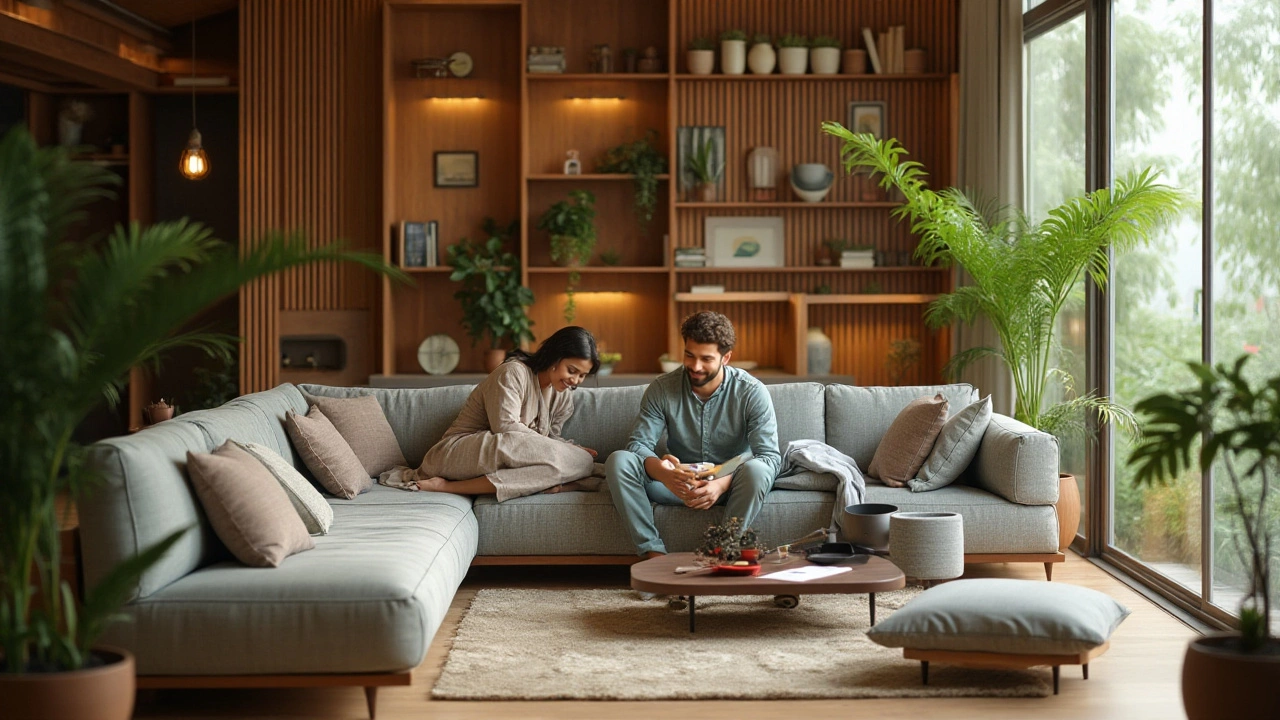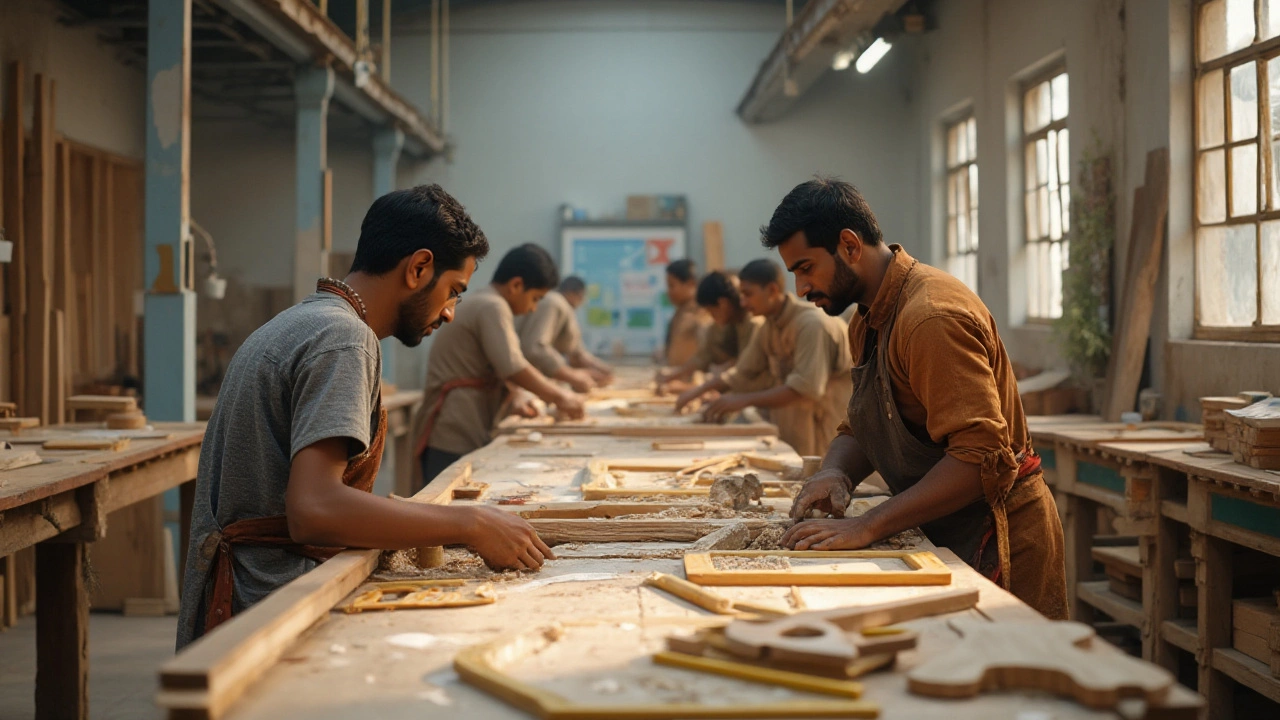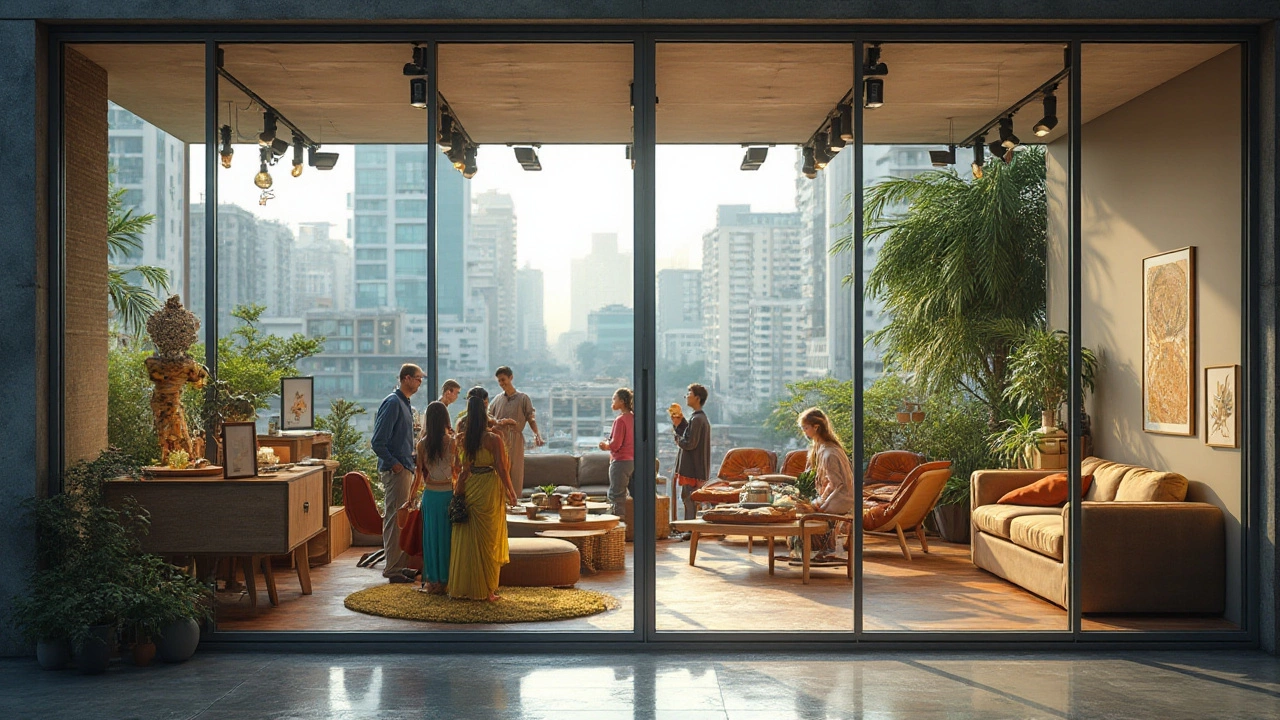The year 2025 marks an exciting chapter for India's furniture industry, a sector on the cusp of a notable boom. As India's urban landscape expands and the middle class flourishes, the demand for furniture that blends functionality with style is rapidly escalating. This is a testament to a country where home and living spaces are gradually becoming a priority.
Indian manufacturers are responding with an array of creative designs tailored to fit modern needs, from compact urban apartments to sprawling traditional homes. What's truly setting the stage apart is the move towards sustainable and eco-friendly furniture, a trend driven by consumers more conscious of their environmental impact.
Moreover, with advancements in technology, from smart furniture to innovative materials, what's available on the market now is more versatile and exciting than ever. For domestic and international brands eyeing expansion, India’s burgeoning furniture industry offers a host of opportunities. This is a narrative of change, creativity, and a market ripe with potential.
- Rising Demand in Urban Areas
- Sustainable and Eco-Friendly Trends
- Innovative Design and Technology Integration
- Opportunities for Domestic and Global Brands
- Changing Consumer Preferences
Rising Demand in Urban Areas
In 2025, the bustling urban landscapes across India are witnessing a marked surge in demand for furniture, primarily driven by rapid urbanization and evolving lifestyles. Cities like Mumbai, Bengaluru, and Delhi are not merely expanding in population but also in aspirations. Urban dwellers are increasingly seeking furniture that can accommodate their fast-paced lifestyles while making optimal use of limited space. The trend is particularly strong among millennials and Gen Z, who favor modern minimalism and functionality. The need for versatile pieces that can serve multiple purposes is at an all-time high, with contemporary designs that fold, tuck away, or expand when needed, fitting seamlessly into compact urban homes.
One might wonder how this shift impacts the way India’s furniture industry is shaping up. Manufacturers are tapping into these urban demands with innovative solutions that prioritize both style and practicality. For instance, modular furniture that adapitates to various room configurations has become a staple offering, enabling homeowners to customize their living spaces without hefty investments. An emerging trend is the usage of multifunctional furniture, like sofa beds or extendable dining tables, which helps maximize usability within limited confines. These pieces cater to the desire for more dynamic and flexible home setups that can easily transition from a workspace to a relaxation zone.
The rise in demand isn't just confined to residential areas; commercial spaces are also undergoing transformations. As co-working hubs proliferate throughout the country, there is a burgeoning need for furniture that supports collaborative work environments while enhancing employee well-being. Ergonomically designed chairs, adjustable desks, and communal tables become essential in facilitating productive and healthy workspaces. A study by the India Brand Equity Foundation highlighted that India's furniture market is expected to grow by 12.91% annually until 2028, with urban areas acting as significant growth drivers. This statistic encapsulates the immense potential held within these markets.
Quoting an industry expert, the CEO of a leading furniture brand shared,
"Urbanization is redefining the Indian home. More than just a necessity, furniture has become an expression of one's personality and living ethos."This sentiment reverberates throughout India's metropolitan regions as consumers increasingly demand personalized and aesthetically pleasing furniture options that resonate with their identities.
Sustainable and Eco-Friendly Trends
In recent years, the furniture industry in India has embraced a transformative shift towards sustainability and eco-friendliness. This trend is not just a fad but a necessary response to the urgent environmental challenges facing the world. Consumers are becoming increasingly aware of the environmental impact of their purchasing decisions, which has led to a surge in demand for furniture made with eco-friendly materials and sustainable practices. Manufacturers are responding by innovating with materials like bamboo, reclaimed wood, and recycled metal, all heralded for their low environmental footprint. The shift is creating a ripple effect throughout supply chains, encouraging sustainable forestry and reducing waste generation.
Indian furniture manufacturers are at the forefront of this revolution, crafting pieces that are not only aesthetically pleasing but also conscientious of the earth's resources. Initiatives to lower carbon footprints join the ranks of these industry changes, with the capture of carbon during production phases becoming a key aspect. India's rich tradition of craftsmanship lends itself seamlessly to creating sustainable furniture as artisans incorporate time-honored techniques with modern eco-centric designs. This synergy results in products that are both innovative and deeply rooted in cultural heritage.
A report from the Confederation of Indian Industry (CII) highlighted that around 70% of urban Indian buyers are willing to pay more for environmentally sustainable products. This creates a lucrative market for innovative design endeavors in furniture manufacturing. Ample opportunities exist for local artisans and large-scale producers to collaborate, highlighting both traditional skills and modern design sensibilities.
According to Pramod Kumar, Director at Environmental Design Solutions, "Our approaches two-century-old traditions with technology-driven production processes aim to minimize waste and responsibly source materials."Such practices are reshaping the industry, making sustainable furniture a standard rather than a niche offering.
To make eco-friendly furniture accessible, many companies are also experimenting with rental and subscription models, allowing consumers to enjoy well-crafted pieces without the permanence of ownership. This model not only reduces waste but also democratizes access to high-quality furniture. Consumer-dealer engagement through these innovative efforts forecasts significant potential growth in the market. Companies are also investing in upcycling and refurbishing programs, turning pre-used furniture into new pieces, emphasizing resourcefulness and sustainability. This approach underlines a commitment to not just the creation but also the lifecycle of furniture.
Statistics from market analyses reveal that this evolving trend is likely to contribute significantly to growth in the Indian market. With a growing emphasis on reducing reliance on new materials, the furniture industry's future seems poised for a sustainable ascent, aligning beautifully with increasing urbanization and environmental consciousness among consumers. As 2025 unfurls, the move towards a more sustainable furniture industry not only enriches homes with responsible choices but also paves the way for a global blueprint in sustainable living. The fusion of technology and traditional craftsmanship sets a promising tone for the decade ahead, with the furniture industry positioned as a beacon of innovation and responsibility.

Innovative Design and Technology Integration
As the furniture industry in India prepares for rapid expansion in 2025, an exciting shift towards innovative design and technology integration is taking center stage. The blend of traditional craftsmanship with cutting-edge technology is crafting a revolutionary narrative in home furnishings, appealing to a spectrum of consumers. The fusion is not just about aesthetics but also functionality, and this combination ensures that furniture can cater to a variety of lifestyle needs, from space constraints to customization. Consider the rise of modular furniture, which showcases brilliance in design harmony and versatility, adapting swiftly to different spaces and functions.
Technology is making an indelible mark on manufacturing processes, allowing for precision that was previously unimaginable. With CNC machines and 3D modeling tools, furniture designers can experiment and produce intricate designs with unprecedented accuracy. This not only elevates the quality of the final products but also opens up a plethora of design possibilities that gorgeously blend with any interior theme. An exciting development is the utilization of Virtual and Augmented Reality, offering customers a sneak peek into how a piece might transform their spaces, long before the purchase, thus enhancing the buying experience.
The surge in smart furniture is another layer adding depth to this wave of innovation. From coffee tables with inbuilt refrigeration and wireless charging capabilities to recliners with embedded massage features, furniture is no longer just about looks but seamlessly integrates digital lifestyles. This category also embraces environmental consciousness, marrying tech and sustainability—think of solar-powered outdoor furnishings or accent pieces made from recycled materials that incorporate smart features. A large segment of the market is seeing vast benefits from this combination and reacting positively to it.
"With the right set of technologies, the potential of smart and innovative furniture is limitless, as it adds value and enriches consumer lifestyles," says a report from the World Economic Forum.
Collaborations between tech companies and traditional furniture firms are also on the rise, leading to a symbiotic relationship that looks promising for the near future. As these partnerships flourish, it brings into focus the idea of homes of the future that are both intelligent and tasteful. These advancements are not happening in isolation; the indigenous design philosophy still holds a significant place, ensuring that no matter how technologically advanced, the touch of Indian artistry remains.
The transition to smart homes heavily influences India's furniture industry, as digital transformation is more accessible than ever before. The 'plug and play' idea is quickly gaining traction, where furniture is ready to connect with home automation systems without the need for extensive, complicated setups. As a result, the home isn't merely a place to live but evolves into an interactive space, enhancing comfort and personalization at every turn.
Opportunities for Domestic and Global Brands
The furniture industry in India presents a colossal opportunity for both domestic and global brands as we move through 2025. Growing consumer demand for customized and elegant furniture is creating a fertile market, attracting local manufacturers to step up their game with novel designs and innovative marketing strategies. These brands are learning to synchronize traditional craftsmanship with modern tastes, a fusion that holds an extraordinary appeal for India's burgeoning middle class. In the face of global competitors, local brands have the advantage of knowing the cultural tastes and lifestyles of Indian consumers, enabling them to cater to preferences effectively.
On the global stage, international brands are eyeing India as a key market in their expansion strategies. Driven by India's untapped potential, these companies bring expertise in high-tech furniture and smart living solutions which are growing in popularity. They collaborate with local companies to enhance their understanding of consumer preferences and distribution networks. Brands from Europe and America, known for their sustainable and innovative designs, appeal to India's eco-conscious consumers. Interestingly, India's demand for imported furniture pieces grew by 20% annually in the previous years, indicating a steady market for international players.
"India's furniture market is attracting global brands looking to tap into the new wave of consumerism. It presents a unique blend of challenges and opportunities," said Anuj S. of Forbes India.
Moreover, the Indian government's support for the Make in India initiative is encouraging both innovation and localization, providing opportunities for global brands to establish manufacturing bases in India. This move not only reduces costs involving import tariffs but also appeals to Indian customers who are increasingly looking for products made locally. Domestic furniture manufacturers are also benefiting from these policies and are able to deliver competitive and quality products.
One should not overlook the digital transformation sweeping the industry. Both global and local companies are investing in digital platforms to market their products, reaching a more extensive customer base than ever before. With tools like augmented reality and 3D visualization, customers can now design and tailor their living spaces online. This tech-savvy approach is increasingly becoming a critical component in the success of both domestic and international brands operating within India. By 2025, experts predict the furniture e-commerce market in India alone could reach $1 billion, further fueling the industry's growth.
Given this landscape, domestic and global brands are positioned to thrive in India's lucrative furniture market, provided they harness these opportunities with strategic planning and innovation. Understanding and adapting to the local cultural sensibilities while leveraging technology and policy trends will be key drivers in setting brands apart, both creatively and competitively. The potential for growth in the Indian furniture industry remains overwhelmingly positive, offering myriad opportunities for brands ready to take advantage of this dynamic and burgeoning sector.

Changing Consumer Preferences
As India strides into 2025, the landscape of consumer preferences within the furniture industry is undergoing a remarkable transformation. This change is largely driven by a younger, more dynamic population that places a high value on individuality and sustainability. Young professionals and families in urban areas are redefining home aesthetics, increasingly favoring pieces that reflect personal style and environmental awareness. In urban centers, the shift is palpably felt, where even the tiniest balconies are curated with an eye for style and comfort, showing just how much design now matters to the Indian consumer.
This evolving trend is not just about aesthetics. Consumers are now seeking out eco-friendly and multi-functional furniture, reflecting a lifestyle that prioritizes both practicality and environmental impact. The modern Indian consumer looks beyond just the functionality of a piece; there's a growing demand for furniture that tells a story. For instance, items made from reclaimed wood or recycled metal are gaining popularity, aligning well with the global push towards sustainability. It's not simply about buying furniture; it's about making a statement.
In addition, technological advancements are fostering a desire for smart furniture that integrates seamlessly with digital lifestyles. From work-from-home setups equipped with wireless charging stations to ergonomic designs that ensure comfort over extended periods, the options are expanding. Brands that can effectively blend technology with design are finding themselves at a distinct advantage. According to a recent report by the India Brand Equity Foundation (IBEF), the furniture sector in India is witnessing a growth rate of around 12% annually, an indication of the rapid pace at which consumer preferences are evolving.
"Today's consumers are keenly aware of the quality, origin, and sustainability of their purchases, and are willing to invest in brands that align with their values," notes Anjali Chopra, a leading industry analyst.
This new era also sees a significant rise in demand for customization. With consumers wanting furniture that fits their unique spaces and tastes, companies are being nudged to offer bespoke solutions. Indian artisans and furniture makers are tapping into this trend by offering customizable options that allow for personal flair. The trend doesn't just broaden market reach, it revitalizes traditional craftsmanship by blending it with modern designs, creating a fusion that's uniquely appealing.
Home decor in India is no longer an afterthought; it's part of the consumer's identity. As preferences shift, the industry's ability to adapt, offering innovative and varied choices, will determine which firms emerge as leaders in this burgeoning field. For furniture manufacturers, adapting to these changes is not just a trend, it's a pathway to thriving in an increasingly competitive market. It’s an exciting time where embracing change is synonymous with innovation and success.

